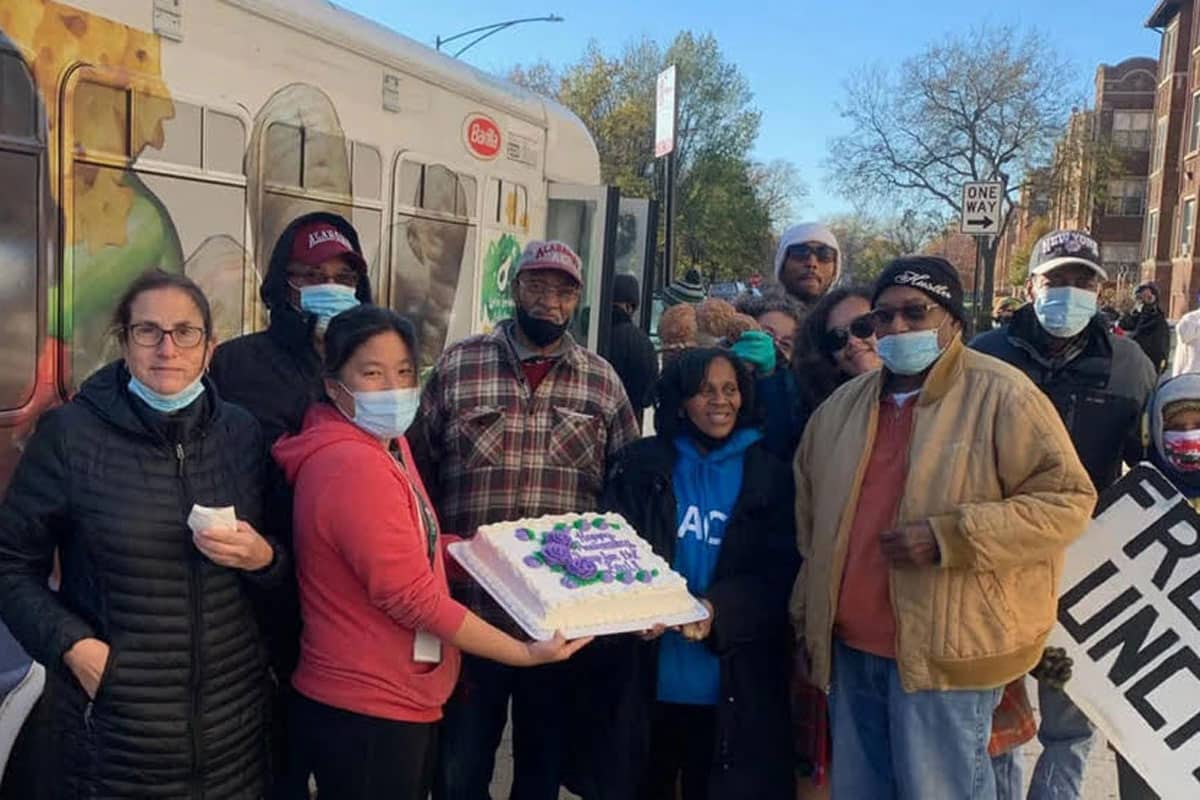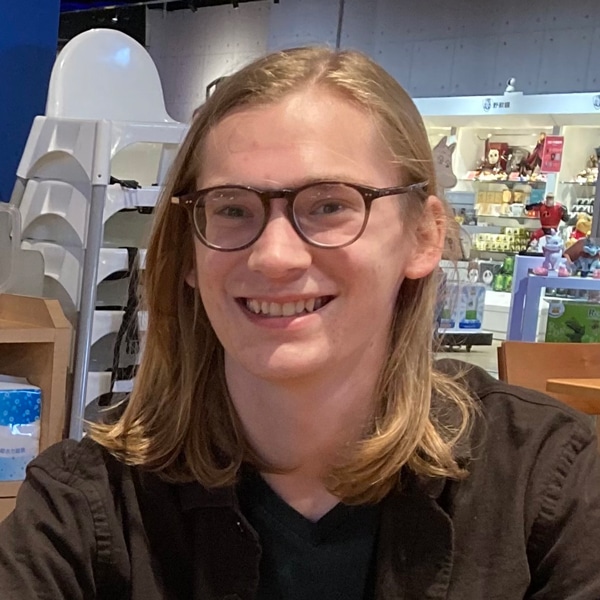Chicago’s First Annual Sukkah Design Fest Brings Together Social Justice and Design
By Zeki Salah, Facilitator, Mutual Aid Collaborative
The first annual Sukkah Design Festival was held on October 9-16, showcasing North Lawndale’s Jewish history and providing social services to the community. Reshorna Fitzpatrick, 2019 Chicago Peace Fellow and Executive Pastor of the Stone Temple Baptist Church, was a member of the organizing committee, which included community-based organizations and design firms. These groups brought the community together to explore the history of North Lawndale through collaborative design projects and built relationships centered around social justice.
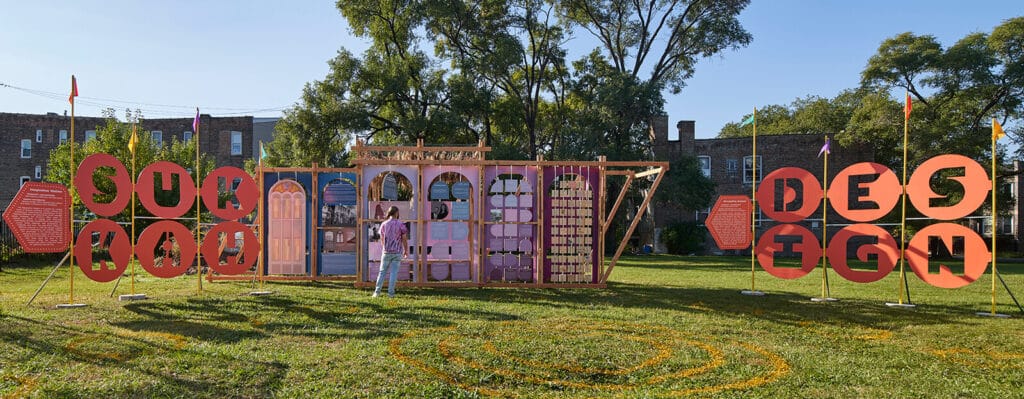
Pastor Reshorna became involved with the Sukkah Design project through her work with the Lawndale Pop-up Spot, a museum housed in a shipping container created by Chelsea Ridley, Jonathan Kelley, and members of the North Lawndale neighborhood. They built the Lawndale Pop-up Spot on a lot owned by Stone Temple Baptist Church, now called the Love Blooms Here Plaza. The Lawndale Pop-Up Spot explores the history of North Lawndale through rotating community-designed exhibits. Given the history between Pastor Reshorna and the Lawndale Pop-up Spot, she gave an enthusiastic yes when Jonathan and Kelly proposed the Sukkah Design Festival. They held the festival from October 9th to October 16th on the Love Blooms Here Plaza, across the street from Stone Temple Baptist Church. The main attraction for the event was a series of Sukkahs which aimed to promote social justice and explore cultural legacy through design.
The Sukkah Design fest created three Sukkahs, temporary outdoor structures, to celebrate the Jewish holiday, Sukkot. Sukkot celebrates the end of harvest time and involves the creation of Sukkahs where community members can gather, eat, and spend time with one another. The festival split participants into three teams. Each team included a Chicago-based design firm and a community-based organization that collaborated to design a Sukkah with a social justice element.
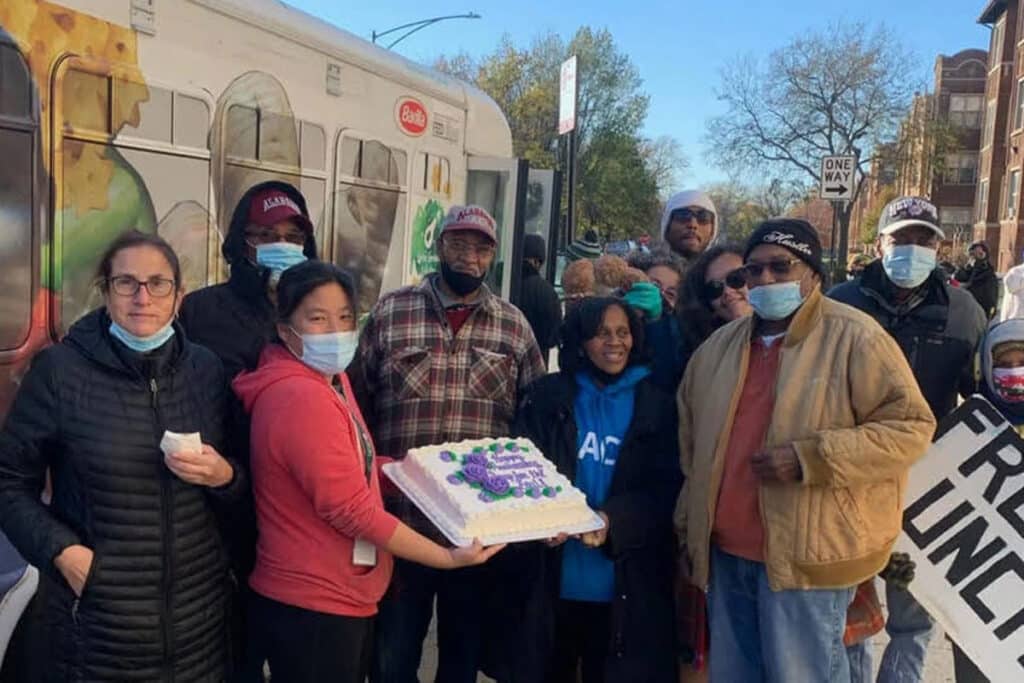
The Young Men's Educational Network (YMEN) partnered with the firm Human Scale to put together a “Giving Sukkah,” where people could receive food and flowers grown by the community. Community-grown food and flowers are a staple of the Love Blooms Here plaza, which has also housed community gardens designed by Pastor Reshorna and another 2020 Chicago Peace Fellow, Annamaria Leon. The Giving Sukkah has now moved to YMEN’s headquarters on Pulaski Boulevard.
Stone Temple Baptist Church worked with the firm New Office to design a micro-museum that explores the history of Stone Temple from 1926 to the present day. The exhibit examines the various stages the building went through as both a synagogue and a church. Current community members were also involved in its design as the team explored what residents love about North Lawndale. Through interviews and community input, the team brought the present neighborhood into conversation with its history.
Men Making a Difference and Open Books – North Lawndale Reads partnered with the Chicago Design Office and Made In Englewood. Together they created an inter-generational “book nook,” which acted as a free library. This Sukkah also served as a space where people of all ages could come together to read or play games. Collectively, all three Sukkahs tackled the issue of food accessibility, explored community assets, and built relationships between people in North Lawndale. Each Sukkah functioned as a hub for discussions, music, and food before they relocated to more permanent sites.
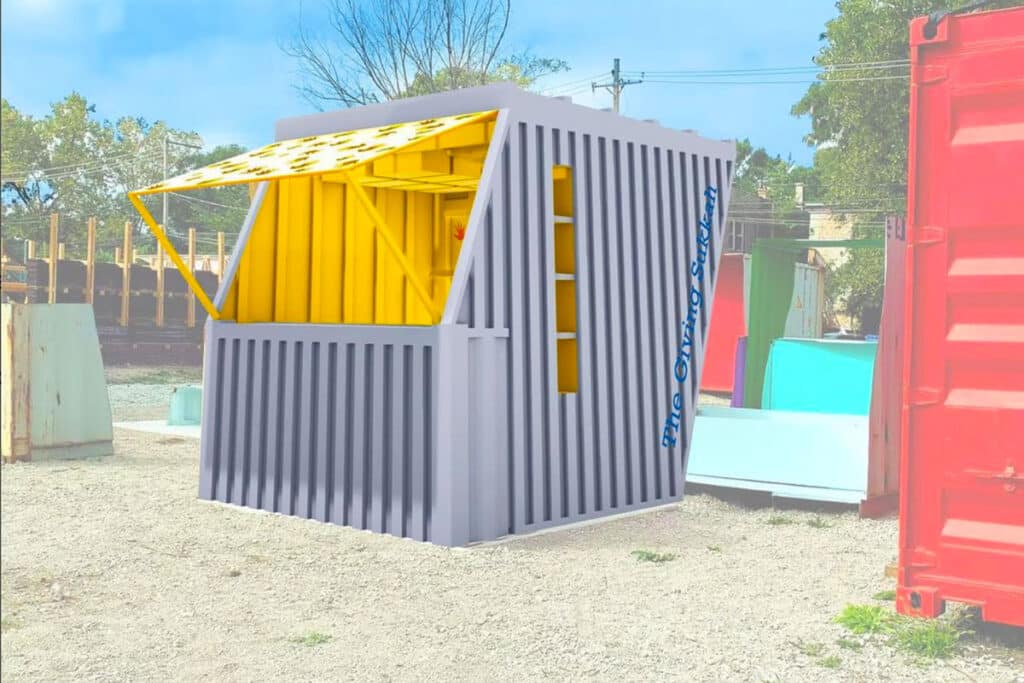
Programming at the Sukkah Design Festival brought members of the North Lawndale community together through meals and conversations about their neighborhood. Food was often a central element of the celebration: Stone Temple held their weekly “Soup for the Soul” food drive within the festival grounds, and various faith-based organizations partnered to organize interfaith dinners throughout the week. Pastor Reshorna noted that “nothing brings people together more than food,” a sentiment that inspired a community clean-up event in which participants celebrated their work picking up trash with a free meal and conversation about environmental justice.
As people gathered around food, festival organizers worked to draw their attention toward the built environment surrounding them. Community organizations gave tours of various Peace Parks in North Lawndale which aim to reactivate vacant lots. The architects and designers of the Sukkahs also held guided tours during Open House Chicago, a city-wide architectural festival. The Sukkah Design Fest inspired conversations about how the built environment can impact issues such as segregation and resource shortages. By gathering the community around food and leading discussions about their neighborhood, the Festival aimed to build new partnerships between designers, faith leaders, and community activists to address these problems.
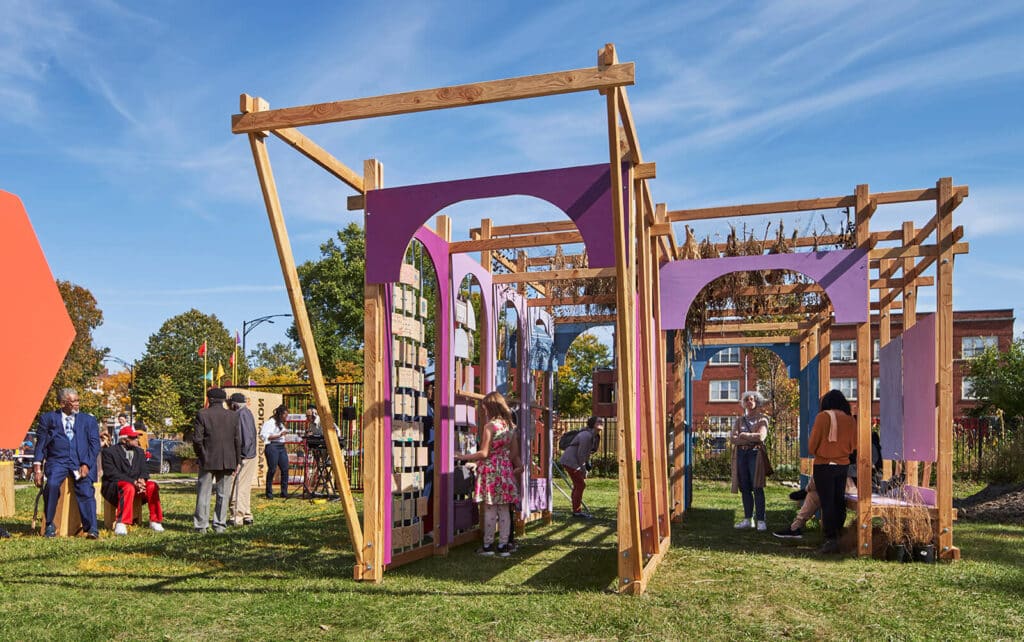
The Sukkah Design Fest built relationships amongst residents in North Lawndale and connected them to different organizations around the city as they planned music, food, and cultural programming. Architects, community members, and community organizations all came together to unite diverse groups of people that would have otherwise not likely come into contact with one another. Sukkot is a holiday associated with food, gathering, and the harvest. The festival used these themes to encourage North Lawndale’s predominantly Black population to explore their neighborhood’s Jewish history alongside traditions of fellowship and kinship. These relationship-building events provided opportunities for residents to make a difference in their community and plan social justice projects from the ground up.
By uniting a diverse range of actors and facilitating collaboration, the Sukkah Design Festival provided valuable assets to an underserved community and empowered residents. The Stone Temple Baptist Church would like to make the Sukkah they designed alongside New Office a permanent mini-exhibition within the church. The exhibit would memorialize the cooperation achieved through Black and Jewish communities through the design festival and preserve a valuable historical artifact to North Lawndale. Stone Temple is currently collecting donations to help fund the installation of the mini-exhibit.
Confessions of a Rebel Architect

Confession: I am an architect.
Architects are skilled at approaching issues from different angles. We have the ability to research a problem and the tools to design a solution that meets a specific problem. In this way, architecture has an amazing potential to contribute to society.
Yet too often the daily realities of the profession result in days full of long meetings picking apart trivial details and reducing the conceptual aspirations of design to shallow one-liners. Architects are often only invited to the project after investors, developers, and other stakeholders outside of the community have established project outcomes based on profit models and resale potential. These realities leave me feeling that as a profession, we are somehow missing the point.

Outside the profession, the term “architect” denotes the idea of a mastermind, a strategic inventor who thinks in big, broad strokes and establishes an impactful plan or course of action. However, inside the profession, the architect’s scope is most often relegated only to the building and the immediate needs of the physical components in the space. We allow ourselves to reduce our impact by only considering design at a building scale. We too often ignore our responsibility to define the built environment at an urban scale, as part of the larger context that imagines the future of how society might convene, collaborate, protest, and thrive.
As an architecture student, I was trained how to generate an idea, how to iterate options for that idea, and how to present and adapt that idea based on feedback. While these tools can be applied to the physical realm of architecture, they are similar to the tools used by community leaders and grassroots activists working at an urban scale. Architects are trained in the skills needed to approach society’s most adaptive challenges.

I recently left an innovative architectural office known for its integration of design with social needs because I had grown frustrated with the limited voice we architects allowed ourselves in the larger discussions around hard topics most affecting our cities and towns. After joining the Goldin Institute, I came to realize the tools the Institute works to instill in grassroots leaders and encourage policy makers to adopt are the very tools that, as architects, we are trained to wield. Focusing only on beauty and form is an irresponsible application of our skills. The role of the architect demands that we understand the legacy of a place, of a people, and translate it into the built environment that holds the next chapter.
It’s time to rebel against the building-scale-only convention of architecture and recapture the holistic legacy of the title. It’s time to train up Rebel Architects who can imagine a more desirable future as a vanguard of new social solutions!
Last year, I partnered with Erin Sterling Lewis, 2017 president of the North Carolina Chapter of the American Institute for Architects (AIA) and co-founder of the Raleigh-based architecture firm in situ studio, to create an initiative that seeks to create conversations centered around a community-driven process leading to responsive design and responsible development that would authentically consider place, context, and social change.

In May 2018, we issued a call to the Raleigh community and its designers to spend three days discussing how social issues and cultural legacy shape city growth. The response was overwhelming. Based on the community’s engagement and interest in the questions posed in the workshop, North Carolina State University contacted us and asked us to facilitate a semester-long architectural class that would ask students to tackle the same issues over an extended period of time and in a more robust way, giving them the chance to expand upon the work that was started by local professionals. This studio is ongoing and we are currently planning for Part 2 of the professional and community workshop to be held in fall 2019.
Our project looks at an 81.2-acre site located southwest of downtown Raleigh, a flourishing city of roughly 500,000 people that is projected to grow another 50% by 2030. The site is currently inhabited by the Governor Morehead School for the Blind and North Carolina’s maximum-security Central Prison. While this site once was located outside the city proper, seemingly a perfect setting to deposit all the city’s “undesirables,” the city has grown so much that it is now centrally located, though still shrouded in isolation and stigma.
The project explores the hypothetical closure of Central Prison and the hypothetical reabsorption and renovation of the Governor Morehead School buildings while incorporating this institution's fantastic work more inclusively into the city. The participants are looking at the legacy of both institutions, what they have offered the city since their establishment, and rethinking ways that their civic impact can benefit the present and expanding urban population.
These conversations with the students and professionals are redefining the current role of the architect as one of optimist, innovator, researcher, community partner and activist. We are approaching urban growth holistically by interviewing teachers and students from the Morehead School and learning from local re-entry organizations. Most importantly, these initiatives are guiding designers to see that built solutions will only succeed at a societal scale if those most affected have leading voices in our design solutions.

This project incorporates the mission of the Morehead School and addresses the disruptive cycles of incarceration and recidivism, but more than that, it has the chance to revitalize a central portion of Raleigh and provide an example of socially responsible city growth to other cities beyond the region. Our group of Rebel Architects has jumped into the exploration with both feet. We are taking seriously our roles as researchers and archivists and adding the rebel’s charge to listen, interpret and improve. The enthusiasm and level of participation, together with the strength in design solutions proposed thus far, is proof that the profession is capable of, and urgently desires, more.
The hope is for this newfound role to take root beyond the confines of this initiative, to seep deep into the ethos of design. Community-driven projects conceived through an authentic process that are facilitated and implemented by Rebel Architects: Now that is a soaring aspiration worthy of the profession.
